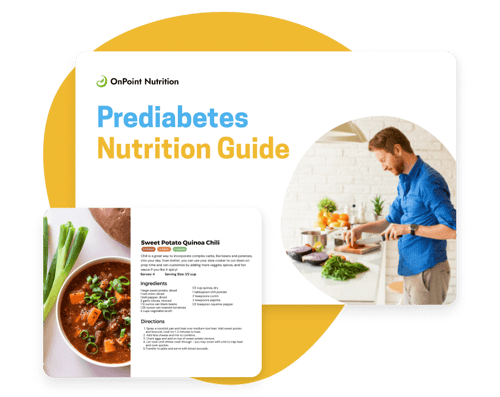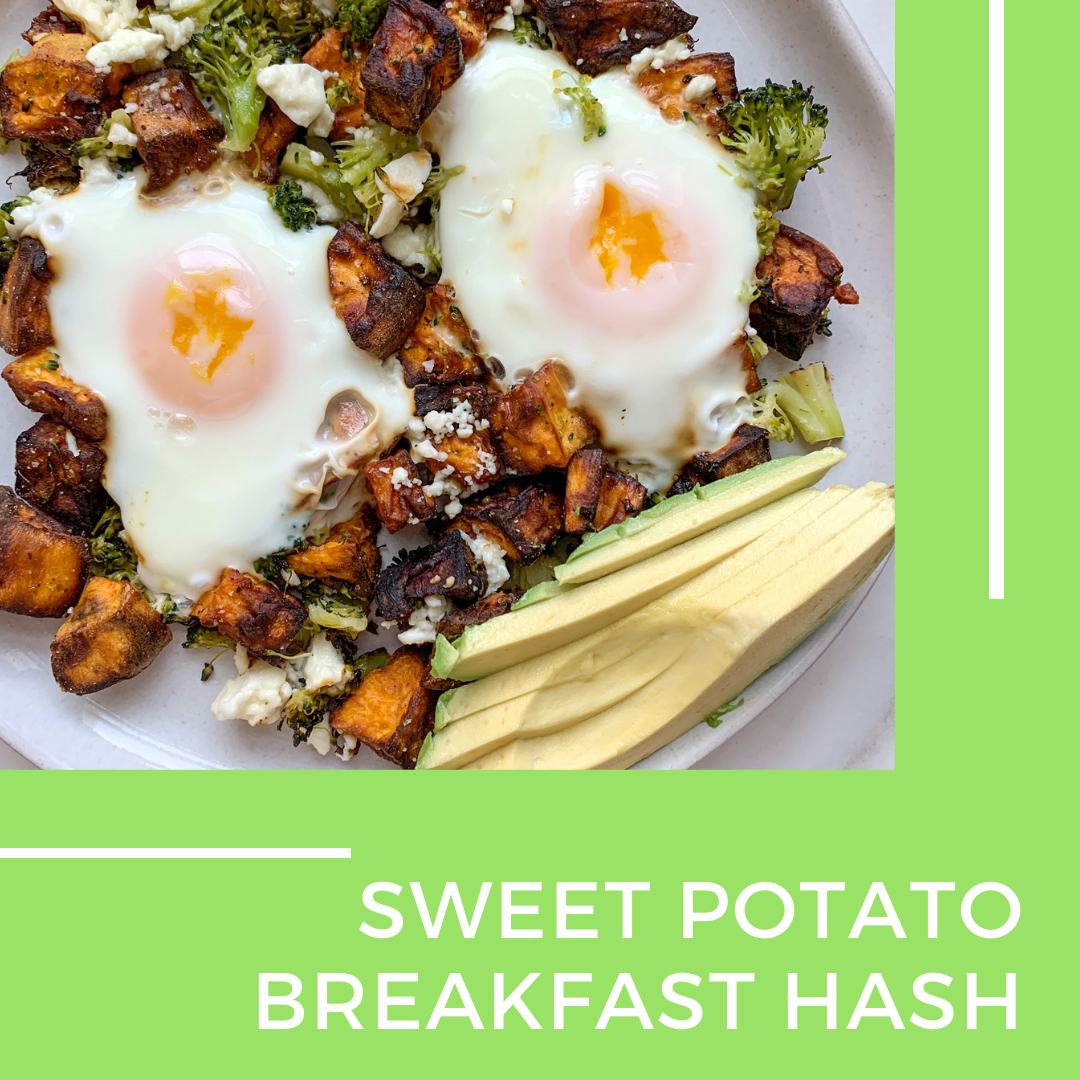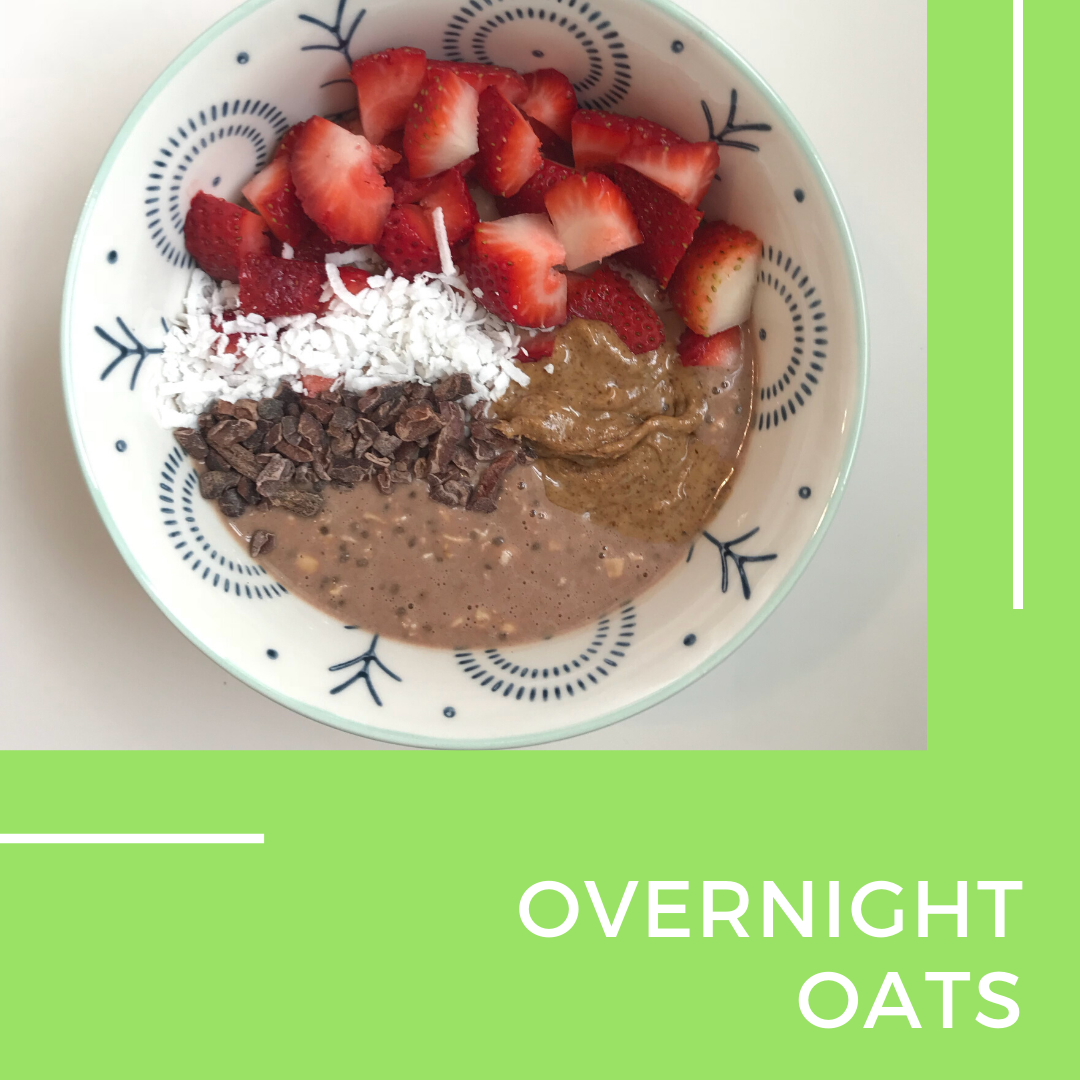Let us help you perfect your prediabetes diet

Reverse your Prediabetes by Eating Better
We want to help you make lasting changes to help reverse prediabetes for good. Use this page as your one stop shop for all information related to prediabetes. From helping you with the basics of foods to eat and foods to avoid for prediabetes, to creating a plan that's specifically tailored to you and your condition- we have it all! Plus, the Glycemic Index and DASH Diet can be very helpful tools in getting your eating habits under control and finding the best foods to build into your new diet.
If you just learned about prediabetes, you are not alone. Although 1 in 3 Americans have it, only 10% are aware of their condition. Think of prediabetes as a flashing warning sign for Type 2 Diabetes, similar to when the 'Check Engine' light comes on in your car.
Prediabetes is marked by:
- Elevated blood sugar (glucose)... but not quite high enough to be considered diabetic
- Often caused by insulin resistance (more on this later)
- Yet, there is plenty you can do RIGHT NOW(!!) to make things better
To learn more about our approach to helping you manage and reverse
your prediabetes click HERE.
What exactly is prediabetes (and, a prediabetes diet)?

Prediabetes is a warning sign that you're heading toward Type 2 Diabetes. The good news is, you've caught it early enough to turn the train around and avoid letting your condition become worse. Before we start to make lifestyle changes, it is helpful to know exactly what prediabetes is. According to the American Diabetes Association, you have prediabetes if:
- Hemoglobin a1c is between 5.7-6.4%
- Fasting Blood Glucose is between 100-125 mg/dL
- Oral Glucose Tolerance Test 2 hours after eating reads between 140-199 mg/dL
Not familiar with this terminology? The a1c % is the percentage of your red blood cells carrying sugars. Blood sugars can also be measured in absolute terms, through a fasting glucose blood test or an oral glucose test.
Concerned you may be at risk?
Learn more about the five likely causes of prediabetes HERE.
So what does this mean?
These statistics typically measure insulin resistance, which means that your body is not using insulin properly. Insulin is a hormone released by the pancreas in response to glucose. When your body is using insulin properly, the process looks like this:

Think of insulin as a key and your cells as a lock. In someone who does not have insulin resistance, insulin unlocks the cells so that glucose exits your blood stream and enters the cells for energy.
In someone with insulin resistance, it's as if the cells have changed the locks. Insulin can no longer interact with cells and be used as energy. Instead, the glucose remains in the blood stream, causing your blood sugar to remain high. As a result, these blood sugar levels appear on your lab tests.
Am I at risk for developing prediabetes?
The difficult characteristic of prediabetes is that many people do not show symptoms until the condition has progressed to Type 2 Diabetes. The best way to detect prediabetes is by conducting regular blood tests as part of your ongoing physical exams with your doctor. It is especially important to be diligent with screening for prediabetes if you have an increased risk of developing the condition.
Risk factors for prediabetes include:
- Weight and waist size Overweight and high fat tissue increase insulin resistance. Studies have also shown a connection between insulin resistance and waist size: men with 40+ inch waist / women with 35+ inch waist.
- Dietary patterns. Eating processed foods and drinking artificially sweetened beverages increases your risk of prediabetes and Type 2 Diabetes.
- Inactivity. Regular exercise helps you control our weight, uses stored glucose as energy, and helps your body's cells avoid insulin resistance.
- Genetic factors such as family history and race / ethnicity Individuals with a family history of diabetes are more likely to develop prediabetes. African Americans, Hispanics, Native Americans, and Asian-Americans are also more likely to develop prediabetes.
- Other conditions Health conditions such as gestational diabetes (for both the mother and the child), polycystic ovarian syndrome, and obstructive sleep apnea, can increase your risk of pre-diabetes.
There are a few other factors associated with overall health that are correlated with prediabetes. High blood pressure, high low-density-lipoprotein cholesterol (the bad kind), and high triglycerides often occur in people with prediabetes. Following a supervised prediabetes diet and being more active can help you better manage all of these conditions.
Want to learn more about how to decrease your risk of developing prediabetes? Click HERE.
How to reverse prediabetes

The Centers for Disease Control and Prevention (CDC) has done extensive research on reversing prediabetes and found three main lifestyle changes that can reduce the risk of developing Type 2 Diabetes by more than 60%. These lifestyle changes are directly related to food choices and movement and have been shown to be even more effective than medication. You and your nutritionist can decide how to best implement these changes into your lifestyle! Learn more about the three main ways to reverse prediabetes below:
Moderate weight loss 5-7%
Research shows that moderate weight loss of 5-7% can drastically reduce the likelihood of developing Type 2 Diabetes. As a reference, this would be a 10-14 pound loss for someone weighing 200 pounds. The Diabetes Prevention Program study identified that changes in food habits and increased movement not only helped people lose the weight, it also helped them keep the weight off. The idea is to maintain a healthy long term weight to avoid your blood sugar re-entering the danger zone. Even if you aren't overweight, developing better habits via a prediabetes diet and incorporating physical activity could be the two missing pieces to the puzzle that will help return your blood sugar back to normal. Let's look into exactly how to go about this...
Regular physical activity
The studies done by the CDC have shown that one of the main contributors to reversing diabetes is incorporating more physical activity. Well you may be wondering how much physical activity is enough? The CDC recommends incorporating a minimum of 150 minutes per week of moderate activity. Moderate activity can be determined by using something called the "talk test". While you're doing your activity, you should be able to talk and carry on a light conversation, but you should not be able to sing a song. Incorporating 150 minutes of movement per week will help with your weight loss goal as well as lowering blood sugar! The type of activity it totally up to you and should be something that you enjoy doing. You may find that you enjoy walking outside with a friend, taking a zumba class, or swimming- the possibilities are endless!
Food choices
Although there can be many contributors to the development of prediabetes, it really boils down to food choices (the elusive prediabetes diet). Your food choices not only directly impact your body's physiological processes, but they can also influence your weight. As you have learned already, weight in itself can be a contributing factor to prediabetes. These components are all connected, and it really comes down to making food choices that will help with weight loss and also help repair the physiological processes in our bodies! But you may be wondering where a prediabetes diet starts. The general principles are to include more high-fiber foods, fresh fruits and vegetables, and lean proteins while limiting highly processed foods and sugary drinks. Let's take a closer look at specific foods that are the building blocks of a prediabetes diet plan.
Curious what the end result could be if you make significant improvements to your diet and lifestyle? Read more about what it looks like to reverse your prediabetes.

Complete a FREE Eligibility Check
Your insurance provider may cover some or all of the cost of your nutrition program.
See if you qualify!
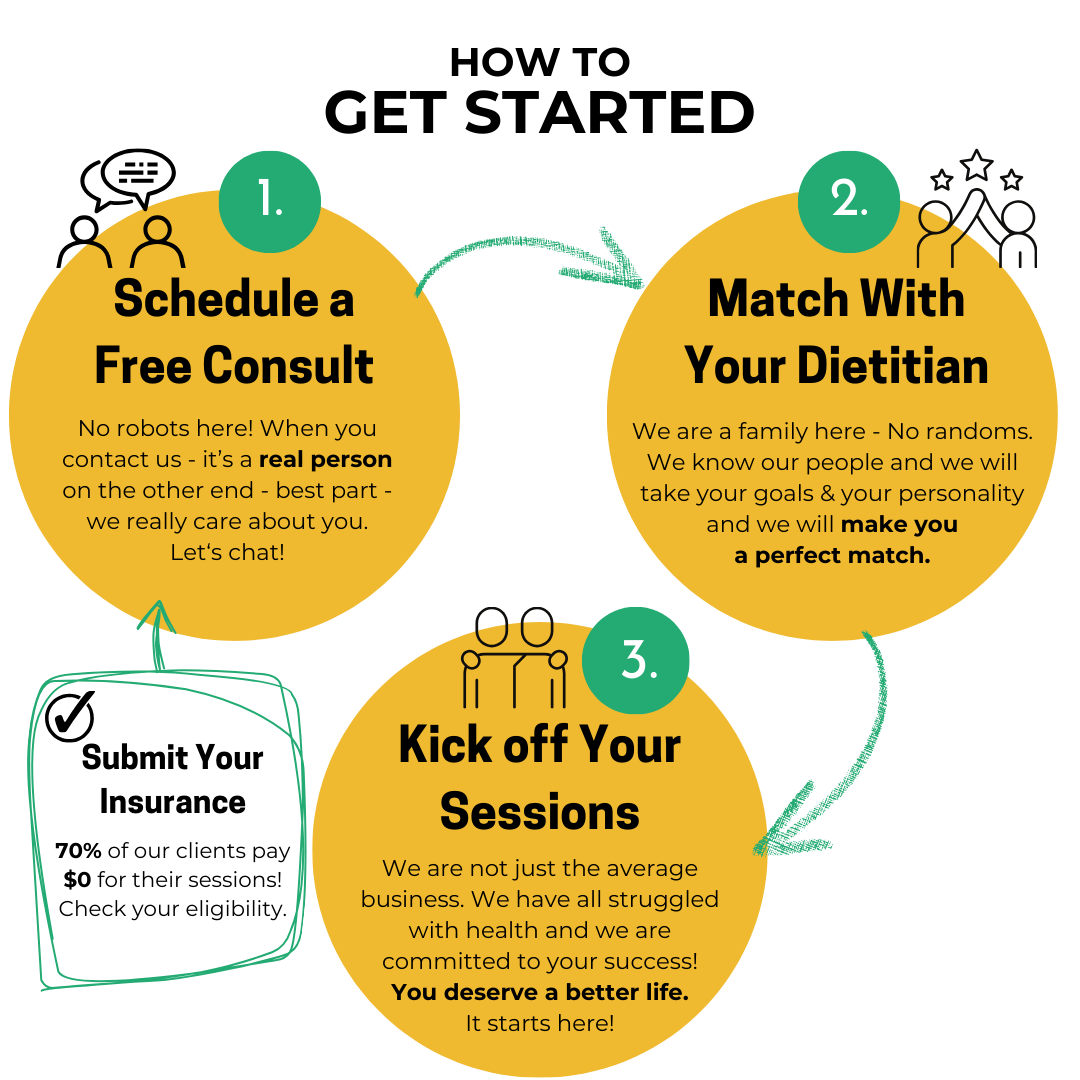
So what foods will help me lower my blood sugar?
As part of a prediabetes diet, we recommend eating foods that are moderately low in carbohydrates and take longer to digest. This helps prevent your blood sugars from sky-rocketing from a large blast of glucose. We recommend including fiber-rich foods, lean proteins, and foods with a low Glycemic Index. Check out our list of foods to include in a prediabetes diet:
For an even more detailed look, read our full blog on the foods to eat for prediabetes
| Food Group | Examples |
|---|---|
|
High Fiber Fiber-rich foods digest and absorb more slowly in the GI system, causing a slower rise in blood sugar. This helps prevent rapid "sugar spikes". |
|
|
Lean Proteins Prediabetes has been linked to other chronic conditions, such as heart disease. Including more lean proteins as opposed to proteins higher in saturated fat can have a cardio-protective effect! |
|
|
Low Glycemic Index A food's glycemic index reflects how quickly any given food will raise your blood sugar. To avoid drastic spikes in blood sugar, choose foods with a low glycemic index. |
|
|
Functional Foods There are also a handful of "functional" foods that can regulate blood sugar levels. Functional foods are naturally occurring foods that are shown to have additional medicinal benefits beyond basic nutrition. |
|
Are there foods I should avoid in my prediabetes diet?
As part of your prediabetes diet, we recommend avoiding processed and refined foods as much as possible. These foods tend to be void of nutrients and have a high Glycemic Index, which can cause drastic spikes in your blood sugar. Try to eat these foods and ingredients sparingly:
- Highly Processed and Refined Foods
Processed and refined foods are extremely low in fiber and nutrients, which tends to absorb more quickly in the GI tract. These are the types of foods that cause drastic spikes in blood sugar. Replacing these foods with more nutrient-dense options will help prolong the release of glucose into the bloodstream.- Trans fats
- White breads, pastas, and rice
- Packaged snack foods
- Foods High in Sugar and Sweeteners
Foods high in sugar and other sweeteners will cause a rapid spike in blood sugar, so avoiding these foods is important for prediabetes management. That being said, you may be wondering why fruit is still considered a "safe" food for managing prediabetes. Fruits are "OK" because the sugar type is natural (vs added) and is far less than you'll find in sweetened products. So instead of these foods, try incorporating some fresh fruits instead to satisfy your sweet tooth!- Flavored coffee drinks
- Sweetened breakfast cereals
- Sugary drinks like soda
- Alcohol
Interested in more details? Read our full blog on foods to avoid for prediabetes
Lifestyle improvements to help manage your prediabetes
Emphasize Portion Control
Portion control is really important in managing and reversing prediabetes. Spikes in your blood sugar are directly related to the amount of food you eat during one meal, mainly carbohydrate-containing foods. The problem is, the portion sizes we are used to eating at restaurants are often much larger than the recommendation. But why is portion size so important? Well, portion control can assist weight loss, which we know is helpful in reversing prediabetes. In addition to reading food labels, use measuring cups, measuring spoons, and a food scale to ensure you're eating an appropriate portion. If you couldn't tell, a major part of your prediabetes diet is portion size.
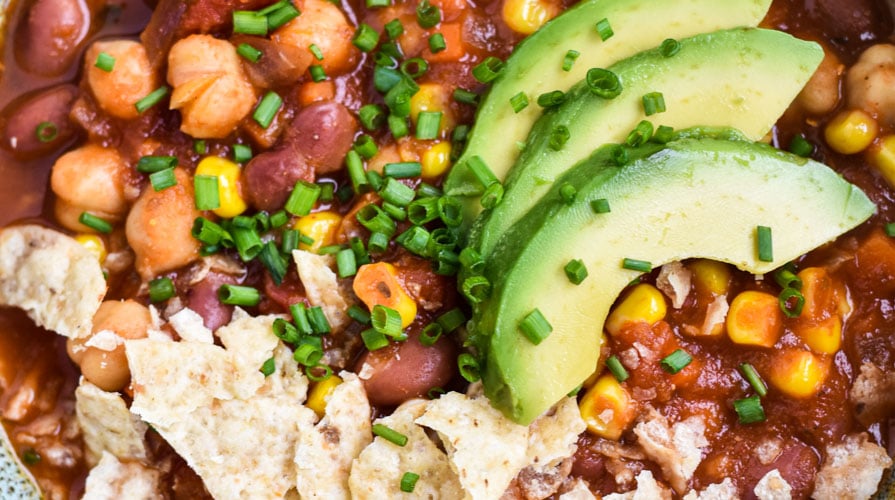
Eat More Fiber
Research shows that a diet high in fiber-rich foods greatly reduces the likelihood of prediabetes progressing to Type 2 Diabetes. Within a prediabetes diet, fiber-rich foods slow down the delivery of glucose into the blood stream, enabling a more gradual rise in blood sugar. Even more, fiber-rich foods tend to keep us satiated for longer periods of time, which helps with weight loss. But don't add a ton of fiber-filled foods at once! Adding too much fiber at one time can upset the GI system, so we recommend starting slow. Gradually add more and more of these foods into your diet to avoid discomfort! Let's take a look at what foods will give you the most fiber.
| Food Group | Examples |
|---|---|
|
Vegetables |
Greens: Kale, Swiss Chard, Beet Greens, Spinach, Romaine Lettuce, Parsley Root Vegetables: Sweet Potato, Beets, Yams, Celery Root, Baby Red/Purple Potatoes Other: Radishes, Celery, Carrot, Cucumber, Cabbage, Cauliflower, Broccoli, Asparagus, Artichoke, Green Beans, Turnips, Parsnips, Brussels Sprouts, Onions, Garlic, Leeks, Zucchini |
|
Fruits |
Orange, Grapefruit, Kiwi, Apple, Pears, Plums, Peaches, Apricots, Nectarines, Bananas, Coconut, Berries |
|
Whole Grains |
Brown Rice, Whole Grain Breads and Pastas, Steel Cut Oats, Quinoa, Whole Barley |
|
Nuts and Seeds |
Seeds: Sunflower, Pumpkin, Flax, Chia, Hemp, Sesame Nuts: Almonds, Cashews, Walnuts, Peanuts, Hazelnuts, Cashews, Pecans |
|
Beans and Legumes |
Beans: Kidney, White, Mung, Black, Pinto, Chickpeas (Garbanzo) Lentils: Red, Brown, Green, French, etc. |
Opt For Water Over Sugary Drinks
There are a few ways to liven up a glass of water to make it a deliciously refreshing beverage:
- Try using an at-home carbonation device like a soda-stream to add bubbles to your water
- Add fruit- oranges, lemons, limes, to your carbonated water
- Directly infuse water with your favorite fruits and flavors
Eat more lean meats
There is a lean meat for you no matter what type of food you like. Take a look at the table below for the lean meats we recommend:
- Fish
- Poultry
- Pork
Try to be more active!
Prediabetes Breakfast
So you just woke up, and all you can think about is making a delicious breakfast. But wait, will what you're craving help with your prediabetes? Don't worry, we've got you covered. Breakfast is the most important meal of the day and fortunately there's so many ways to fit in nutritious foods and still make it delicious!
Prediabetes Lunch
You started off the day feeling good after your prediabetes-friendly breakfast, but now it's time to think about lunch. You want to make something nutritious and delicious, but let's be honest, it has to be quick and easy too. Ain't nobody got time to spend hours making their lunch! Try out some of these simple, prediabetes-friendly recipes that will keep you full and satisfied through your busy day!
Prediabetes Dinner
You made it! The last big meal of the day. You're probably wondering, "how could I possibly find ANOTHER prediabetes-friendly meal that is packed with nutrients and just as tasty as my breakfast and lunch?". Well, you've come to the right place. We've created some unbelievable dinner recipes that are sure to satisfy your cravings and your health goals.
Learn to follow the Glycemic Index
The Glycemic Index helps you pick foods that will not cause dramatic changes in blood sugar
The Glycemic Index is a number that tells you how fast or how slow your body converts carbohydrates into blood sugar. The scale ranges from 1 to 100; for a prediabetes diet, the lower the number, the better:
- 55 or less = Low (good)
- 56 - 69 = Medium
- 70 or higher = High ("bad")
Research suggests that focusing on foods with low-glycemic index carbohydrates and high fiber may protect against diabetes and cardiovascular disease. Specifically, another study found that increased fiber may improve glucose control within the cardiovascular system. You can use food labels to estimate the Glycemic Index value of a particular food. There are also efforts to add a "low GI" symbol to packaged foods.
Glycemic Index labeling is also supported by various scholarly publications. There are a few things to keep in mind, however. The Glycemic Index value for a specific food can vary depending on:
- How you cook it
- How old the food is
- Fat and fiber tend to lower glycemic index
- For example, the longer you cook pasta, the lower the glycemic index.
- The glycemic index increases in fruits (such as bananas, peaches, etc.) as they ripen.
As we have mentioned elsewhere, portion size is nearly as important as the specific food you eat. Within the GI framework, this is called Glycemic Load. Whereas the index indicates how quickly glucose enters the blood stream, Glycemic Load tells you how much glucose per serving could be introduced into your system.
Glycemic Index vs. Glycemic Load
For example, watermelon has a high Glycemic Index value (80), but a Glycemic Load of only 5 because the food has relatively little carbohydrates. You can calculate a food's glycemic load by multiplying the per-serving carbohydrate level by the glycemic index and dividing by 100. Above 20 is high, 11 to 19 is moderate, and 10 and below is considered low.
Ultimately, when building a meal plan to better regulate your blood sugar, it is important to be mindful of all three key metrics:
- The total carbohydrates in your food
- The speed with which a food will increase your blood glucose: glycemic index
- The ultimate level to which your blood glucose could rise: glycemic load
This is just a start for your prediabetes diet. See our full list of glycemic index foods.
What about the Dash Diet for prediabetes? Should I try it?
The DASH Diet was originally developed to treat hypertension. It's even in the name: Dietary Approach to Stop Hypertension. Over time, researchers have found that DASH methods are also effective on improving prediabetes. In addition to its benefits on hypertension, the DASH framework improves insulin resistance and obesity/weight loss. Backed by the National Institutes of Health's Heart, Lung, and Blood Institute, the DASH plan is highly aligned with our general tips for an effective prediabetes diet:
- Fruits
- Vegetables
- Whole grains
- And low-fat dairy foods
- Meat, fish, poultry
- Nuts
- Beans
- Limited in sugar-sweetened foods and beverages, red meat, and added fats
Generally speaking, these foods are low in saturated fat, total fat, cholesterol, and sodium and high in potassium, calcium, magnesium, fiber, and protein. Scientists developed the DASH diet through a series of smaller, specific studies. The DASH diet prescribes the food groups above based upon your gender and age.
Learn the DASH diet's specific recommendations in our detailed blog.
Here is the OnPoint approach to helping people build a successful prediabetes diet:
- Our prediabetes meal plans emphasize eating:
- Complex carbohydrates such as beans, vegetables and high-fiber starches
- High protein meats such as chicken, fish, and pork
- Various low glycemic index foods that can help regulate your blood sugar levels
- Our plans for people with diabetes take into consideration the time and how much food you are eating, so as to avoid natural spikes or crashes in your glucose levels
- We preach moderation, helping you to find realistic and achievable ways to reach your goals.

Backed by science
Our prediabetic programs are based upon the latest science and aligned with CDC protocols

Tailored just for you
Our nutritionists build your unique plan based upon your body type, food preferences, and lifestyle

Work with experts
Our team includes certified diabetes educators (CDEs) with hands-on experience working with prediabetic clients
Questions? Contact Us!
“My team and I would be honored to be part of your health journey! Our priority is your health and happiness; no goal is too big or too small. We look forward to working with you soon!”





